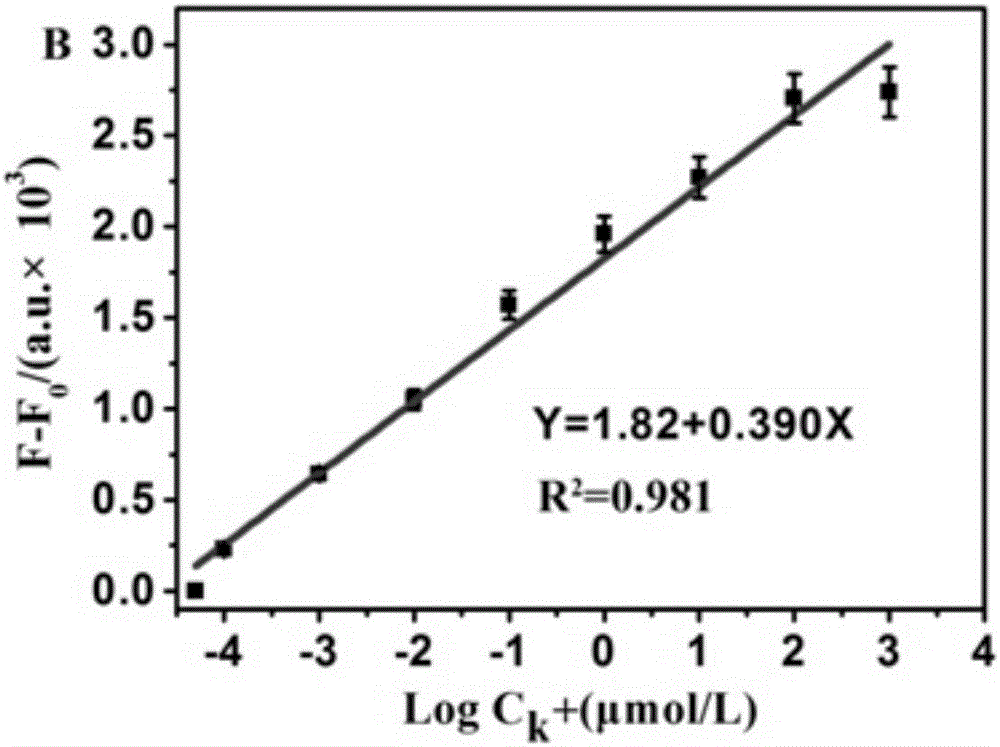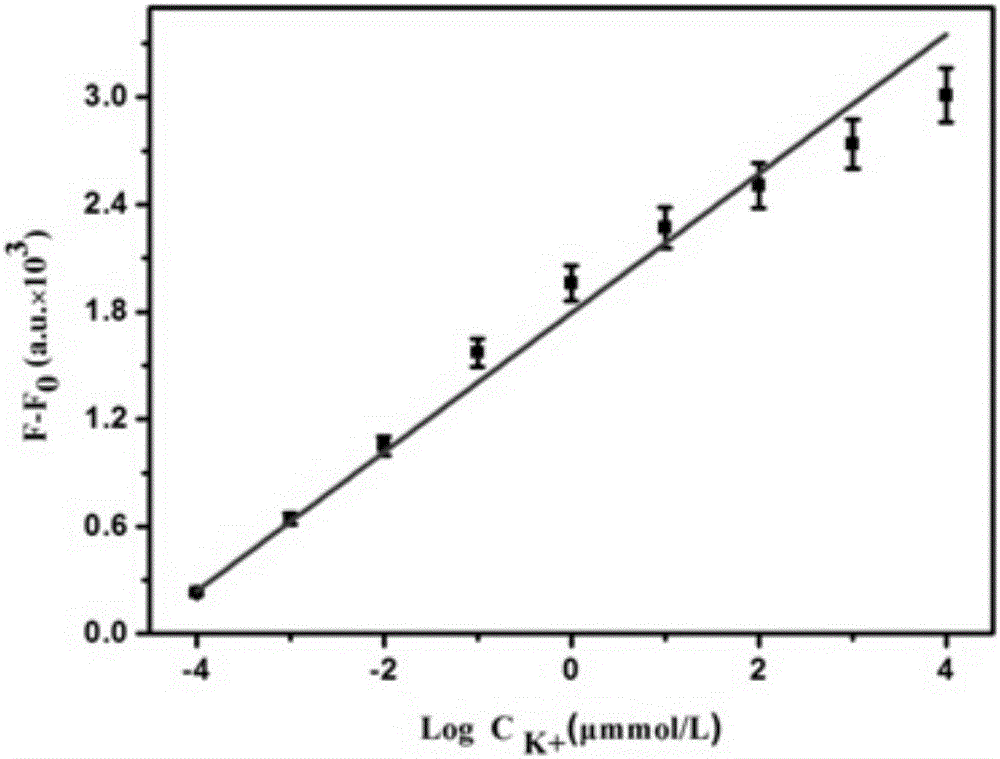Method of using silver nanocluster to detect potassium ion concentration in vitreous fluid to deduce death time
A technique of potassium ion concentration and time of death
- Summary
- Abstract
- Description
- Claims
- Application Information
AI Technical Summary
Problems solved by technology
Method used
Image
Examples
Embodiment 1
[0041] The method of detecting the concentration of potassium ions in the vitreous humor by silver nanoclusters in this embodiment and estimating the time of death is carried out according to the following steps:
[0042] (1) Preparation of fluorescent DNA-AgNCs: Take 90 μL of 50 μM DNA solution at 4°C at 12000 rpm, take 50 μL of the bottom layer liquid into a centrifuge tube, and add 54 μL of 500 μM AgNO in the centrifuge tube 3 solution and 102 μL of secondary water, shake at room temperature for 30 minutes; subsequently, add 54 μL of 500 μM NaHB prepared in ice water 4 solution, shaken for 5 minutes, and stored in a 4°C refrigerator for 3 hours to obtain a brownish-yellow liquid, that is, a fluorescent DNA-AgNCs solution. ;
[0043] The DNA chain nucleotide sequence used in this example is the DNA sequence shown in the nucleotide sequence table ID NO.6;
[0044] (2) Preparation of potassium ion concentration and fluorescence intensity standard curve: preparation concentra...
Embodiment 2
[0049] The method of detecting the concentration of potassium ions in the vitreous humor by silver nanoclusters in this embodiment and estimating the time of death is carried out according to the following steps:
[0050] (1) Preparation of fluorescent DNA-AgNCs: Take 100 μL of 50 μM DNA solution at 4°C at 12000 rpm, take 60 μL of the bottom layer liquid into a centrifuge tube, add 108 μL of 500 μM AgNO in the centrifuge tube 3 solution and 204 μL of secondary water, shake at room temperature for 30 minutes; subsequently, add 108 μL of 500 μM NaHB prepared in ice water 4 The solution was shaken for 5 minutes and stored in a refrigerator at 4°C for 3 hours to obtain a brownish yellow liquid, namely the fluorescent DNA-AgNCs solution. spare;
[0051] The DNA chain nucleotide sequence used in this example is the DNA sequence shown in the nucleotide sequence table ID NO.6;
[0052] (2) Prepare the standard curve of potassium ion concentration and fluorescence intensity: prepare ...
Embodiment 3
[0057] The method of detecting the concentration of potassium ions in the vitreous humor by silver nanoclusters in this embodiment and estimating the time of death is carried out according to the following steps:
[0058] (1) Preparation of fluorescent DNA-AgNCs: Take 100 μL of 50 μM DNA solution at 4°C at 12000 rpm, take 60 μL of the bottom layer liquid into a centrifuge tube, add 108 μL of 500 μM AgNO in the centrifuge tube 3 solution and 204 μL of secondary water, shake at room temperature for 30 minutes; subsequently, add 108 μL of 500 μM NaHB prepared in ice water 4 The solution was shaken for 5 minutes and stored in a refrigerator at 4°C for 3 hours to obtain a brownish yellow liquid, namely the fluorescent DNA-AgNCs solution. spare;
[0059] The DNA chain nucleotide sequence used in this example is the DNA sequence shown in the nucleotide sequence table ID NO.6;
[0060] (2) Prepare the standard curve of potassium ion concentration and fluorescence intensity: prepare ...
PUM
 Login to View More
Login to View More Abstract
Description
Claims
Application Information
 Login to View More
Login to View More - R&D
- Intellectual Property
- Life Sciences
- Materials
- Tech Scout
- Unparalleled Data Quality
- Higher Quality Content
- 60% Fewer Hallucinations
Browse by: Latest US Patents, China's latest patents, Technical Efficacy Thesaurus, Application Domain, Technology Topic, Popular Technical Reports.
© 2025 PatSnap. All rights reserved.Legal|Privacy policy|Modern Slavery Act Transparency Statement|Sitemap|About US| Contact US: help@patsnap.com



